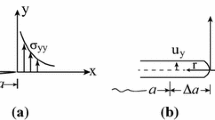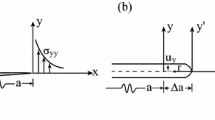Abstract
The propagation process of an interfacial crack in composite material is studied using the modified maximum dilatational strain energy density criterion, NT-criterion. Some necessary assumptions have been adopted to facilitate the use of the NT-criterion in this case. The stress intensity factors at the crack tip are extracted from the complex displacement field and finite element results. A simple algorithm for automatic crack propagation is presented with an illustrative example.
Résumé
On étudie le processus de propagation d'une fissure d'interface dans un matériau composite en utilisant le critère NT, version modifiée du critère de densité d'énergie maximale de dilatation. On a adopté diverses hypothèses pour faciliter l'application du critère NT à ce cas. Les facteurs d'intensité de contraintes à l'extrémité de la fissure sont déduits du champ de déplacement complexe et des résultats de l'analyse par éléments finis. Un algorithme simple relatif à une propagation automatique de la fissure est présenté avec un exemple à la clé.
Similar content being viewed by others
References
M.J. Iremonger and W.G. Wood, Journal of Strain Analysis 2 (1967) 239–245.
T.F. MacLaughlin, Journal of Composite Materials 2 (1968) 44–55.
W.L. Ko, Journal of Composite Materials 12 (1978) 97–115.
S. Gaggar and L.J. Broutman, International Journal of Fracture 10 (1974) 606–608.
G.C. Sih and E.P. Chen, Engineering Fracture Mechanics 6 (1974) 343–359.
J.M. Mahishi and D.F. Adams, Journal of Composite Materials 16 (1982) 457–469.
J.M. Mahishi and D.F. Adams, Journal of Materials Science 18 (1983) 447–456.
Y.T. Yeow, D.H. Merris and H.F. Brinson, Experimental Mechanics (1979) 1–8.
J.F. Mandell, Su-Su Wang and F.J. McGarry, Journal of Composite Materials 9 (1975) 266–287.
R.E. Smelser, International Journal of Fracture Mechanics 15 (1979) 135–143.
N.A.B. Yehia and M.S. Shephard, Engineering Fracture Mechanics 26 (1987) 371–382.
N.A.B. Yehia, Engineering Fracture Mechanics 22 (1985) 189–199.
N.A.B. Yehia, “Automatic Tracking of Crack Growth via Finite Elements”, Ph.D. dissertation, Civil Engineering Department (1984) Rensselaer Polytechnic Institute, Troy, NY 12180.
P.S. Theocaris and N.P. Andrianapoulas, International Journal of Fracture 20 (1982) R125-R130.
G.C. Sih and E.P. Chen, Journal of Composite Materials 7 (1973) 230–244.
M. Stern and C.C. Hong, in Advances in Engineering Science, 2, Proceedings 13th Annual Meeting Society of Engineering Science, Hampton, Virginia (November 1–3, 1976) (NASA CP-2001) 699–710.
R.S. Barsoum, International Journal for Numerical Methods in Engineering 10 (1976) 25–37.
G.S. Burd, “An Automatic Finite Element Mesh Generator and Adaptive Geometry Database for Tracking General Two Dimensional Crack Growth”, Masters thesis, Department of Mechanical Engineering, Rensselaer Polytechnic Institute (1984).
Author information
Authors and Affiliations
Rights and permissions
About this article
Cite this article
Yehia, N.A.B., Shephard, M.S. Automatic crack growth tracking of bimaterial interface cracks. Int J Fract 37, 123–135 (1988). https://doi.org/10.1007/BF00041715
Received:
Accepted:
Issue Date:
DOI: https://doi.org/10.1007/BF00041715




